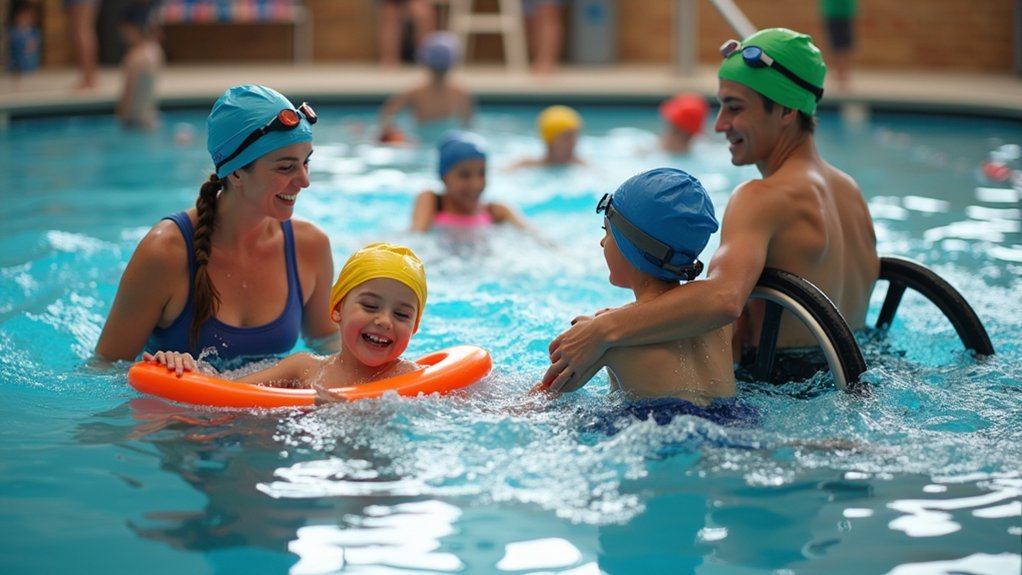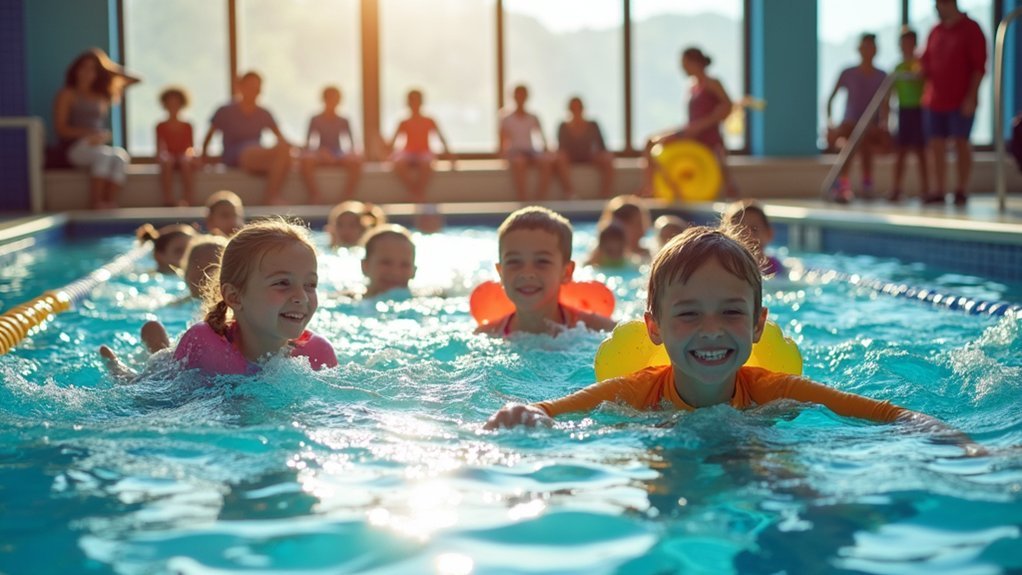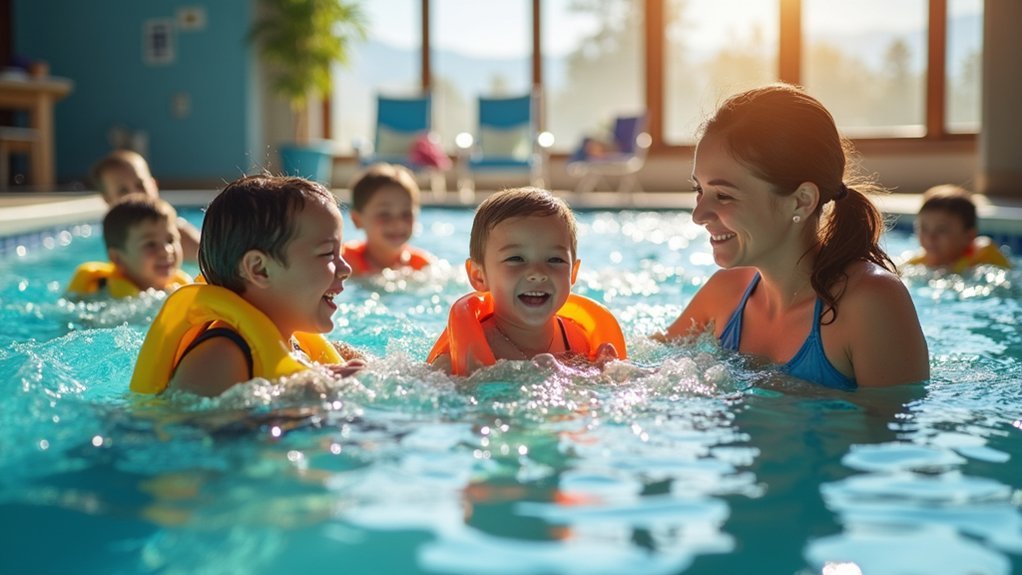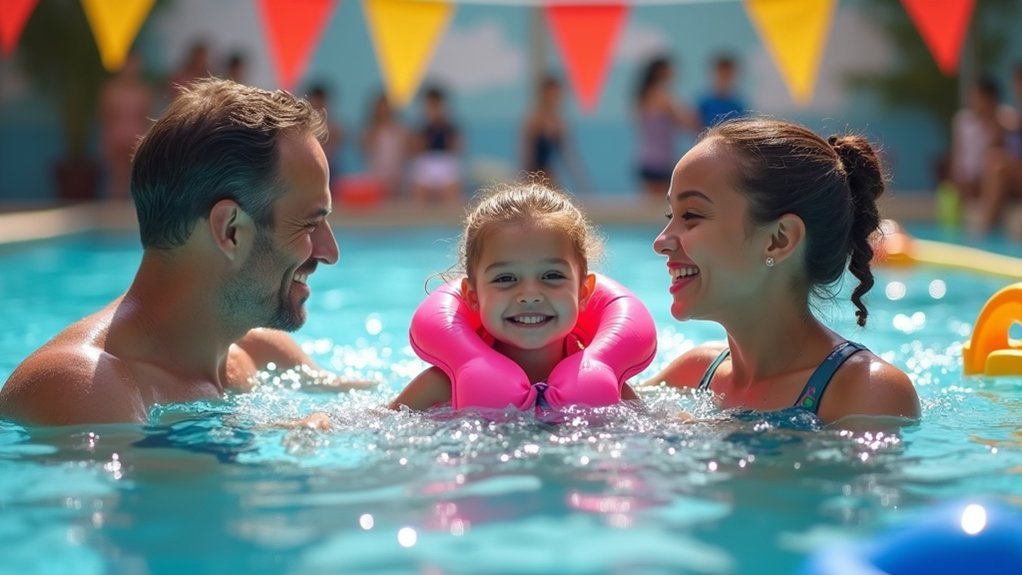Adaptive swimming provides unique benefits for people of all abilities. You’ll experience improved muscle strength without joint strain while enhancing your mental well-being through stress-reducing water activities. Programs offer individualized approaches tailored to your specific sensory, cognitive, or physical needs with specialized equipment and qualified instructors. You’ll build confidence through personalized goal-setting and positive reinforcement in a supportive environment. Discover how the right program can transform both your physical capabilities and self-assurance through the healing power of water.
The Transformative Benefits of Adaptive Aquatic Programs

Water offers a unique environment where individuals of all abilities can thrive physically and mentally. When you participate in adaptive swimming, you’ll experience improved muscle strength without the joint strain that often accompanies land-based exercises. This makes it ideal if you have mobility challenges or conditions like arthritis.
Beyond physical benefits, you’ll notice significant improvements in your mental well-being. Swimming releases stress-reducing endorphins while building self-confidence as you master new skills. The independence you gain in water often translates to increased autonomy in daily life.
For those with specific conditions, adaptive swimming provides targeted benefits—enhancing motor skills and coordination for individuals with autism, offering gentle rehabilitation after surgery, and improving cardiovascular health for everyone involved. Water’s natural buoyancy reduces stress on joints, making it particularly effective for those with chronic pain conditions.
Creating a Supportive Environment for All Abilities
Creating a truly inclusive aquatic environment begins with understanding that every swimmer brings unique needs and abilities to the pool.
Diversity in water isn’t just embraced—it’s fundamental to creating meaningful aquatic experiences for everyone.
You’ll need to establish safety as your foundation while implementing individualized approaches that accommodate sensory, cognitive, and physical differences. Collaborating with healthcare professionals can significantly improve the development of tailored lesson plans that address specific requirements.
Your facility should prioritize:
- Accessible equipment – Provide adaptable tools that can be modified for various abilities
- Clear communication – Use visual aids and diverse communication strategies to reach all learners
- Trained instructors – Guarantee your staff has specialized training in adaptive swimming techniques
- Positive reinforcement – Celebrate achievements and milestones to build confidence
Finding the Right Adaptive Swimming Program in Your Area

How do you navigate the sea of options when searching for the perfect adaptive swimming program? Start by checking local aquatic centers and YMCAs, which often offer specialized instruction. Online directories and recommendations from other families can also point you toward quality programs. Programs like Swim Angelfish utilize the Swim Whisperers® Methodology developed specifically for children with special needs.
| Program Features | What to Look For | Why It Matters |
|---|---|---|
| Instructor Qualifications | Specialized certification in adaptive methods | Guarantees proper technique and safety |
| Class Structure | 1:1 or small group options | Provides personalized attention |
| Program Flexibility | Accommodations for specific needs | Adapts to your child’s unique abilities |
When evaluating programs, consider instructor experience with your child’s specific needs, observe a class if possible, and don’t hesitate to ask about their adaptive methodologies. The right program will offer both personalized instruction and a supportive community environment.
Essential Equipment and Techniques for Successful Water Therapy
Successful water therapy relies on having the right equipment and techniques to accommodate diverse needs and abilities. When you’re preparing for adaptive swimming sessions, make sure you’ve got access to ramps or lifts for easy pool entry, along with specialized flotation devices that provide support while encouraging independence. Instructors prioritize water safety training by teaching essential floating techniques and position transitions before advancing to swim strokes.
Water therapy success hinges on proper equipment that adapts to individual needs while promoting both support and independence.
- Adaptive equipment like swim paddles, gloves, and fins can greatly improve propulsion for those with limited strength.
- Sensory tools provide tactile feedback, helping swimmers become comfortable with water sensations.
- Communication aids such as visual cue cards enhance instruction for non-verbal participants.
- Individualized learning plans tailored to each swimmer’s abilities make certain everyone progresses at their own pace.
The weightlessness of water offers relief from physical pain while promoting freedom of movement, making swimming an ideal therapeutic activity.
Building Confidence and Skills Through Personalized Swimming Journeys

Personalized swimming journeys transform hesitant beginners into confident swimmers through carefully tailored approaches that respect individual needs and challenges.
You’ll experience lessons adapted to your specific learning style, with instructors who recognize your unique obstacles, whether they’re fear-based or physical limitations.
As you progress, you’ll notice improvements not just in technique but in your overall confidence. This transformation occurs through individualized goal-setting and consistent positive reinforcement focused on your achievements.
For children and individuals with special needs, these personalized approaches are particularly effective, fostering both water safety skills and self-assurance. Instructors help students track their swimming by logging improvements and celebrating each milestone achieved.
Your swimming journey benefits from flexible scheduling and customized pacing that minimizes anxiety while maximizing skill development.
The result? You’ll build lasting confidence that extends beyond the pool.
Frequently Asked Questions
How Do Adaptive Swimming Lessons Differ From Traditional Swim Classes?
Adaptive swimming lessons offer you personalized one-on-one instruction tailored to your specific needs, unlike traditional classes. They include specialized equipment, trained instructors, and environmental modifications to accommodate various disabilities and challenges you might face.
Are There Financial Assistance Options for Adaptive Swimming Programs?
Yes, you’ll find numerous financial assistance options for adaptive swimming programs including dedicated scholarships, grants from organizations like AOAP, reduced-cost programs based on income, and support from foundations specifically serving neurodiverse participants.
What Qualifications Should Adaptive Swim Instructors Have?
Adaptive swim instructors should have prior swim teaching experience, understanding of various disabilities, specialized equipment knowledge, and appropriate certifications. You’ll want someone trained in adaptive techniques who can personalize instruction to your specific needs.
How Is Progress Measured in Adaptive Swimming Programs?
In adaptive swimming programs, you’ll see progress measured through skill assessments, subjective evaluations of emotional responses, regular feedback, and trackable goals. These metrics are customized to meet your specific abilities and needs.
Can Siblings Join the Same Adaptive Swimming Class?
Yes, your siblings can join the same adaptive swimming class. You’ll benefit from shared experiences, mutual support, and tailored instruction. Instructors adjust teaching methods to accommodate everyone’s abilities in small-ratio classes like semi-private or group formats.
In Summary
When you embrace swim adapted programs, you’re opening doors to aquatic experiences for everyone. You’ll witness confidence bloom as participants discover their abilities rather than limitations. Remember, water’s natural buoyancy creates the perfect equalizer for inclusive recreation. Don’t wait—reach out to local programs today and become part of a community where everyone belongs in the water, regardless of ability.





Leave a Reply